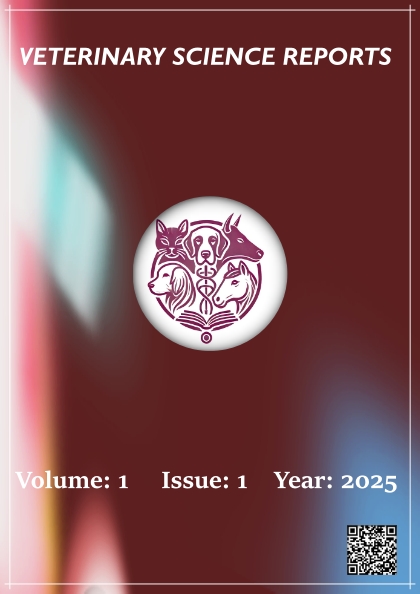Nodular Typhlitis Associated with Heterakis spp. in Golden Pheasants (Chrysolophus pictus): A Pathological and Immunohistochemical Investigation
DOI:
https://doi.org/10.5281/zenodo.15366952Keywords:
Golden pheasant, Heterakis, nodular typhlitis, perivascular wall tumorAbstract
In this report, we detail nodular typhlitis associated with Heterakis spp. in golden pheasants (Chrysolophus pictus), with a focus on clinical and pathological findings. Necropsies found hemorrhagic ceca filled with multifocal white nodules. Histopathological analysis has showed necrotic foci, inflammatory infiltrations and parasite fragments in the submucosa and tunica muscularis, and perivascular spindle-cell proliferations assumed a whirling pattern consistent of perivascular origin. Masson’s trichrome staining revealed only limited peripheral collagen, whereas the core nodules consisted of mesenchymal spindle cells with vimentin and α-smooth muscle actin (α-SMA) positivity, along with focal S-100 reactivity in some sections and uniform desmin negativity. While leiomyomas have been reported in Heterakis infections, the immunophenotypic profile—characterized by diffuse vimentin and SMA, occasional S-100 positivity, and absence of desmin—suggests a lesion with perivascular or undifferentiated mesenchymal features rather than a classical smooth muscle neoplasm or neurogenic tumor. Our observations thus expand the spectrum of pathological outcomes following chronic Heterakis infection in pheasants and underscore the value of immunohistochemistry in characterizing such spindle-cell lesions.
References
Ayeni, J. S. O., Dipeolu, O. O., & Okaeme, A. N. (1983). Parasitic infections of the grey-breasted helmet guinea-fowl (Numida meleagris galeata) in Nigeria. Veterinary Parasitology, 12(1), 59–63. https://doi.org/10.1016/0304-4017(83)90088-2
Balaguer, L., Romano, J., Nieto, J. M., & Fernandez, J. P. (1992). Nodular typhlitis of pheasants caused by Heterakis isolonche: further evidence of a neoplastic nature. J. Zoo & Wildlife Med, 23(2), 249–253.
Boros, Z., Bojan, A., & Cozma, V. (2020). The relationships that occur between parasitic infections and neoplasmic formations in humans and animals. Sci Parasitol, 21(3), 142–149.
Callinan, R. B. (1987). Nodular typhlitis in pheasants caused by Heterakis isolonche. Australian Veterinary Journal, 64(2), 58–59. https://doi.org/10.1111/j.1751-0813.1987.tb16131.x
Chijiwa, K., Uchida, K., & Tateyama, S. (2004). Immunohistochemical evaluation of canine peripheral nerve sheath tumors and other soft tissue sarcomas. Veterinary Pathology, 41(4), 307–318. https://doi.org/10.1354/vp.41-4-307
Cohrs, P. (1966). Textbook of the Special Pathological Anatomy of Domestic Animals. Pergamon Press.
Cram, E. (1927). Bird Parasites of the Nematode Suborders Strongylata, Ascaridata, and Spirurata. Smithsonian Institution. U.S. National Museum Bulletin 140. U.S. Government Printing Office.
Draycott, R. A., Parish, D. M., Woodburn, M. I., & Carroll, J. P. (2000). Spring survey of the parasite Heterakis gallinarum in wild-living pheasants in Britain. The Veterinary Record, 147(9), 245–246. https://doi.org/10.1136/vr.147.9.245
Fedynich, A. M. (2008). Heterakis and Ascaridia. In C. Atkinson, N. Thomas, & D. HUnter (Eds.), Parasitic Diseases of Wild Birds (pp. 388–412). Wiley-Blackwell.
Gilbertson, D. E., & Hugghins, E. J. (1964). Helminth Infections in Pheasants from Brown County, South Dakota. The Journal of Wildlife Management, 28(3), 543. https://doi.org/10.2307/3798206
Griner, L. A., Migaki, G., Penner, L. R., & McKee, A. E. (1977). Heterakidosis and Nodular Granulomas Caused by Heterakis isolonche in the Ceca of Gallinaceous Birds. Veterinary Pathology, 14(6), 582–590. https://doi.org/10.1177/030098587701400605
Gürler, A. T., Bölükbaş, C. S., Pekmezci, G. Z., Umur, S., & Açici, M. (2012). [Helminths of pheasant (Phasianus colchicus) detected by necropsy and faecal examination in Samsun, Turkey]. Türkiye Parazitolojii Dergisi , 36(4), 222–227. https://doi.org/10.5152/TPD.2012.54
Halajian, A., Kinsella, J. M., Mortazavi, P., & Abedi, M. (2013). The first report of morbidity and mortality in golden pheasant, chrysolophus pictus, due to a mixed infection of heterakis gallinarum and h. isolonche in iran. Turkish Journal of Veterinary and Animal Sciences, 37(5), 611–614. https://doi.org/10.3906/vet-1206-31
Helmboldt, C. F., & Wyand, D. S. (1972). Parasitic neoplasia in the golden pheasant. Journal of Wildlife Diseases, 8(1), 3–6. https://doi.org/10.7589/0090-3558-8.1.3
Himmel, L., & Cianciolo, R. (2017). Nodular typhlocolitis, heterakiasis, and mesenchymal neoplasia in a ring-necked pheasant (Phasianus colchicus) with immunohistochemical characterization of visceral metastases. Journal of Veterinary Diagnostic Investigation, 29(4), 561–565. https://doi.org/10.1177/1040638717707555
Jones, T., Hunt, R., & King, N. (1997). Veterinary Pathology (6th ed.). Williams & Wilkins.
JPC. (2024, October). JPC Systemic Pathology. (2024, October). Digestive System (D-P11): Golden pheasant (Chrysolophus pictus) cecal heterakiasis. Joint Pathology Center. https://www.askjpc.org/vspo/show_page.php?id=VSs1MFljeTV3VC9SOENZQXJsYmp3Zz09
Krahnert, R. (1952). Sarkoides Leiomyom nach Heterakidenbefall. Monatshefte Für Veterinärmedizin, 7, 71–75.
Madsen, H. (1941). The Occurrence of Helminths and Coccidia in Partridges and Pheasants in Denmark. The Journal of Parasitology, 27(1), 29. https://doi.org/10.2307/3272883
Maplestone, P. (1932). The genera Heterakis and Pseudaspidodera in Indian hosts. Indian Journal of Medical Research, 20, 403–420.
Mendonça, J. M. de. (1953). Heterakis isolonche Linstow, 1906 e Heterakis gallinae (Gmelin, 1790), agentes causais da Tiflite verrucosa em faisões no Jardim Zoológico do Distrito Federal. Memórias Do Instituto Oswaldo Cruz, 51(0), 675–687. https://doi.org/10.1590/s0074-02761953000100021
Menezes, R. C., Tortelly, R., Gomes, D. C., & Pinto, R. M. (2003). Nodular Typhlitis Associated with the Nematodes Heterakis gallinarum and Heterakis isolonche in Pheasants: Frequency and Pathology with Evidence of Neoplasia. Memorias Do Instituto Oswaldo Cruz, 98(8), 1011–1016. https://doi.org/10.1590/S0074-02762003000800005
Millán, J., Gortazar, C., & Villafuerte, R. (2004). Ecology of nematode parasitism in red-legged partridges (Alectoris rufa) in Spain. Helminthologia, 41(1), 33–37. https://researchers.unab.cl/en/publications/ecology-of-nematode-parasitism-in-red-legged-partridges-alectoris
Norton, R. A., Hoerr, F. J., Clark, F. D., & Ricke, S. C. (1999). Ascarid-associated hepatic foci in Turkeys. Avian Diseases, 43(1), 29–38. https://doi.org/10.2307/1592759
Olsen, O. W., & Braun, C. E. (1980). Helminth parasites of band-tailed pigeons in Colorado. Journal of Wildlife Diseases, 16(1), 65–66. https://doi.org/10.7589/0090-3558-16.1.65
Pence, D., Young, V. E., & Guthery, F. S. (1980). Helminths of the ring-necked pheasant Phasianus colchicus (Gmelin) (Phasianidae), from the Texas Panhandle. Undefined.
Rizzoli, A., Manfredi, M., Rosso, F., Rosa, R., Cattadori, I., & Hudson, P. (1999). Intensity of nematode infections in cyclic and noncyclic rock partridge (Alectoris graeca saxatilis) populations. Parassitologia, 41(4), 561–566.
Schwartz, B. (1924). Occurrence of nodular typhlitis in pheasants due to Heterakis isolonche in North America. J Amer Vet Med Assoc, 65, 622–625.
Soulsby, E. (1982). Helminths, Arthropods and Protozoa of Domesticated Animals (7th ed.). Bailliere Tindall.
Tompkins, D. M., Parish, D. M. B., & Hudson, P. J. (2002). Parasite-Mediated Competition among Red-Legged Partridges and Other Lowland Gamebirds. The Journal of Wildlife Management, 66(2), 445. https://doi.org/10.2307/3803177
Downloads
Published
How to Cite
Issue
Section
License
Copyright (c) 2025 Volkan Ipek, Serife Tasan, Adem Milletsever, Gozde Okuyucu, Mustafa Furkan Pala

This work is licensed under a Creative Commons Attribution 4.0 International License.



